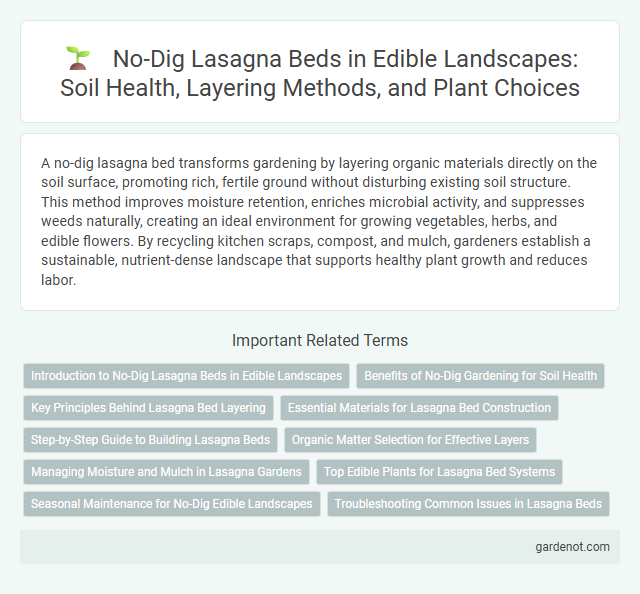A no-dig lasagna bed transforms gardening by layering organic materials directly on the soil surface, promoting rich, fertile ground without disturbing existing soil structure. This method improves moisture retention, enriches microbial activity, and suppresses weeds naturally, creating an ideal environment for growing vegetables, herbs, and edible flowers. By recycling kitchen scraps, compost, and mulch, gardeners establish a sustainable, nutrient-dense landscape that supports healthy plant growth and reduces labor.
Introduction to No-Dig Lasagna Beds in Edible Landscapes
No-dig lasagna beds revolutionize edible landscapes by layering organic materials to create nutrient-rich soil without disturbing the earth. This technique mimics natural decomposition processes, enhancing soil fertility and moisture retention while suppressing weeds. Ideal for sustainable gardening, no-dig lasagna beds support healthy plant growth and reduce labor-intensive soil preparation.
Benefits of No-Dig Gardening for Soil Health
No-dig lasagna beds improve soil health by preserving soil structure and encouraging beneficial microbial activity. The layered organic materials suppress weeds while enriching soil nutrients, reducing the need for chemical fertilizers. This gardening method promotes better moisture retention and aeration, leading to healthier, more productive plants.
Key Principles Behind Lasagna Bed Layering
No-dig lasagna beds rely on layering organic materials to build rich, fertile soil by mimicking natural decomposition processes. Key principles include alternating green nitrogen-rich layers with brown carbon-rich layers to balance nutrients and promote microbial activity. Maintaining moisture and avoiding soil disturbance preserves soil structure and encourages beneficial organisms essential for plant growth in edible landscapes.
Essential Materials for Lasagna Bed Construction
Essential materials for constructing a no-dig lasagna bed include layers of carbon-rich brown materials such as straw, dried leaves, and cardboard combined with nitrogen-rich green materials like kitchen scraps, grass clippings, and fresh plant trimmings. A base layer of moist newspaper or cardboard suppresses weeds while facilitating moisture retention and airflow. Adding a final top layer of nutrient-rich compost or well-rotted manure provides necessary fertility to support robust edible plant growth.
Step-by-Step Guide to Building Lasagna Beds
Creating a no-dig lasagna bed begins with layering organic materials such as cardboard or newspaper to suppress weeds and retain moisture. Follow by alternating nitrogen-rich green materials like grass clippings with carbon-rich brown materials such as straw or dried leaves, building the layers approximately 12-18 inches thick. Water each layer thoroughly to accelerate decomposition, allowing the bed to settle and become fertile for planting edible crops within 4-6 weeks.
Organic Matter Selection for Effective Layers
Selecting organic matter for a no-dig lasagna bed involves layering diverse materials rich in carbon and nitrogen to create nutrient-dense soil. Incorporate brown layers such as straw, dry leaves, or shredded paper with green layers like kitchen scraps, fresh grass clippings, and coffee grounds to balance decomposition and moisture retention. Using compost or well-rotted manure enhances microbial activity, accelerating nutrient cycling and supporting robust edible plant growth.
Managing Moisture and Mulch in Lasagna Gardens
No-dig lasagna beds maintain optimal moisture levels by layering organic materials that naturally retain water and reduce evaporation. Thick mulch layers such as straw or shredded leaves protect the soil surface, keeping it cool and moist while suppressing weed growth. Proper moisture management encourages healthy microbial activity, promoting nutrient cycling essential for productive edible landscapes.
Top Edible Plants for Lasagna Bed Systems
Kale, spinach, and Swiss chard thrive in no-dig lasagna beds due to their nutrient-demanding nature and shallow roots. Companion plants like beans and peas enrich soil nitrogen, boosting overall bed fertility. Herbs such as basil and oregano deter pests while enhancing flavor, making them ideal for layering in edible lasagna bed systems.
Seasonal Maintenance for No-Dig Edible Landscapes
Seasonal maintenance for no-dig lasagna beds involves layering organic materials such as compost, mulch, and plant debris to replenish nutrients and improve soil structure without disturbing the soil. Regularly adding nitrogen-rich amendments in spring and incorporating carbon-rich mulch in fall supports microbial activity and moisture retention throughout the year. Monitoring moisture levels and removing weeds also ensures optimal conditions for edible plants in no-dig landscapes.
Troubleshooting Common Issues in Lasagna Beds
Poor drainage often causes waterlogging in no-dig lasagna beds, leading to root rot and stunted plant growth. To resolve this, incorporate coarse materials like straw or wood chips between organic layers to improve aeration and water flow. Pest infestations, such as slugs and snails, can be mitigated by introducing natural predators or applying organic deterrents like diatomaceous earth around vulnerable plants.
No-dig lasagna bed Infographic

 gardenot.com
gardenot.com